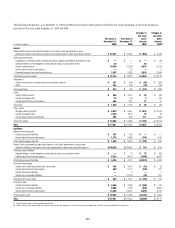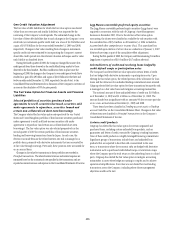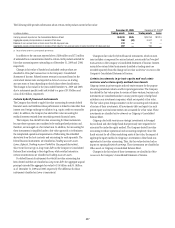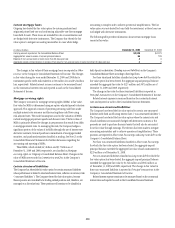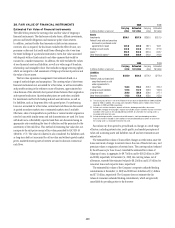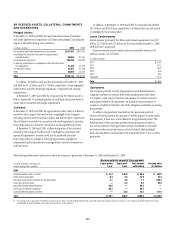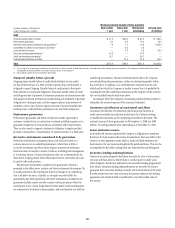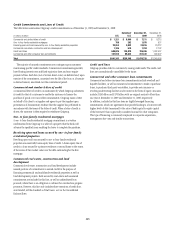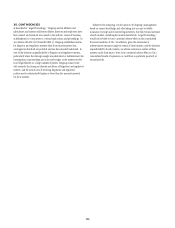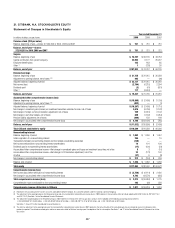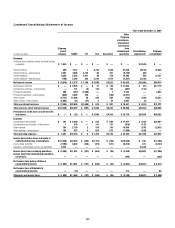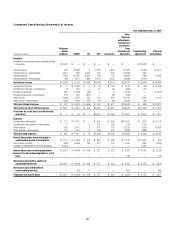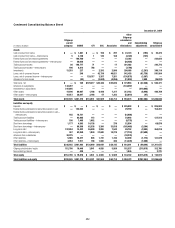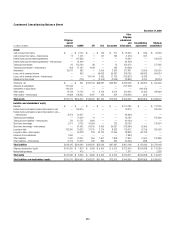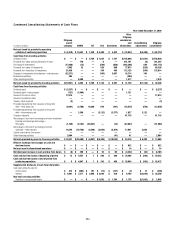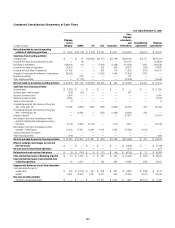Citibank 2009 Annual Report Download - page 255
Download and view the complete annual report
Please find page 255 of the 2009 Citibank annual report below. You can navigate through the pages in the report by either clicking on the pages listed below, or by using the keyword search tool below to find specific information within the annual report.
245
Credit Commitments and Lines of Credit
The table below summarizes Citigroup’s credit commitments as of December 31, 2009 and December 31, 2008:
In millions of dollars U.S.
Outside of
U.S.
December 31,
2009
December 31,
2008
Commercial and similar letters of credit $ 1,321 $ 5,890 $ 7,211 $ 8,215
One- to four-family residential mortgages 788 282 1,070 937
Revolving open-end loans secured by one- to four-family residential properties 20,914 3,002 23,916 25,212
Commercial real estate, construction and land development 1,185 519 1,704 2,702
Credit card lines 649,625 135,870 785,495 1,002,437
Commercial and other consumer loan commitments 167,510 89,832 257,342 309,997
Total $841,343 $235,395 $1,076,738 $1,349,500
The majority of unused commitments are contingent upon customers’
maintaining specific credit standards. Commercial commitments generally
have floating interest rates and fixed expiration dates and may require
payment of fees. Such fees (net of certain direct costs) are deferred and, upon
exercise of the commitment, amortized over the life of the loan or, if exercise
is deemed remote, amortized over the commitment period.
Commercial and similar letters of credit
A commercial letter of credit is an instrument by which Citigroup substitutes
its credit for that of a customer to enable the customer to finance the
purchase of goods or to incur other commitments. Citigroup issues a letter
on behalf of its client to a supplier and agrees to pay the supplier upon
presentation of documentary evidence that the supplier has performed in
accordance with the terms of the letter of credit. When a letter of credit is
drawn, the customer is then required to reimburse Citigroup.
One- to four-family residential mortgages
A one- to four-family residential mortgage commitment is a written
confirmation from Citigroup to a seller of a property that the bank will
advance the specified sums enabling the buyer to complete the purchase.
Revolving open-end loans secured by one- to four-family
residential properties
Revolving open-end loans secured by one- to four-family residential
properties are essentially home equity lines of credit. A home equity line of
credit is a loan secured by a primary residence or second home to the extent
of the excess of fair market value over the debt outstanding for the first
mortgage.
Commercial real estate, construction and land
development
Commercial real estate, construction and land development include
unused portions of commitments to extend credit for the purpose of
financing commercial and multifamily residential properties as well as
land development projects. Both secured-by-real-estate and unsecured
commitments are included in this line, as well as undistributed loan
proceeds, where there is an obligation to advance for construction progress
payments. However, this line only includes those extensions of credit that,
once funded, will be classified as Total loans, net on the Consolidated
Balance Sheet.
Credit card lines
Citigroup provides credit to customers by issuing credit cards. The credit card
lines are unconditionally cancellable by the issuer.
Commercial and other consumer loan commitments
Commercial and other consumer loan commitments include overdraft and
liquidity facilities, as well as commercial commitments to make or purchase
loans, to purchase third-party receivables, to provide note issuance or
revolving underwriting facilities and to invest in the form of equity. Amounts
include $126 billion and $170 billion with an original maturity of less than
one year at December 31, 2009 and December 31, 2008, respectively.
In addition, included in this line item are highly leveraged financing
commitments, which are agreements that provide funding to a borrower with
higher levels of debt (measured by the ratio of debt capital to equity capital
of the borrower) than is generally considered normal for other companies.
This type of financing is commonly employed in corporate acquisitions,
management buy-outs and similar transactions.


